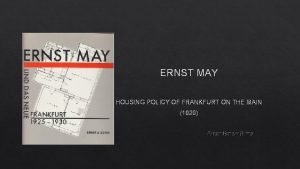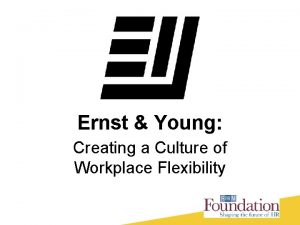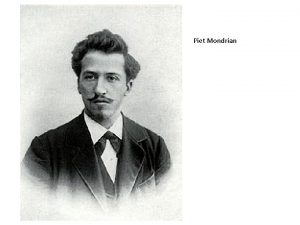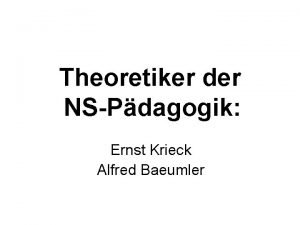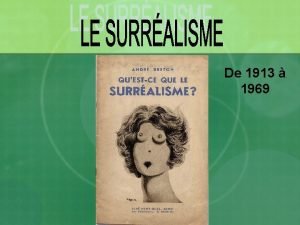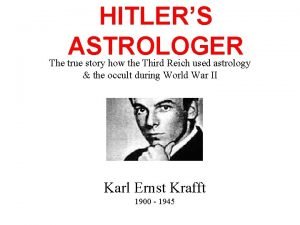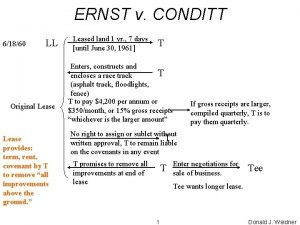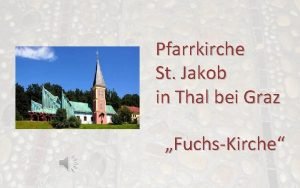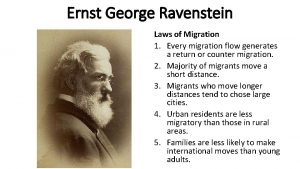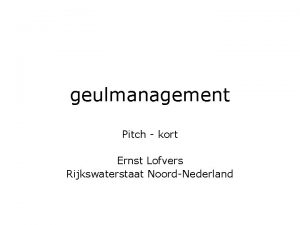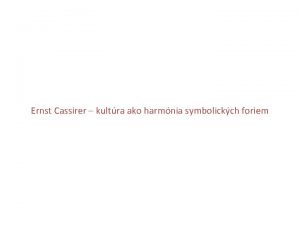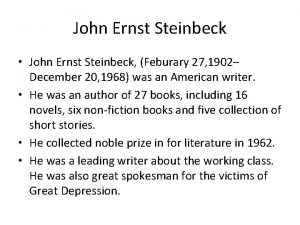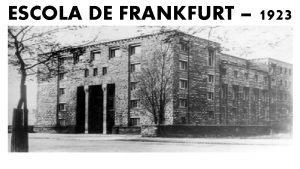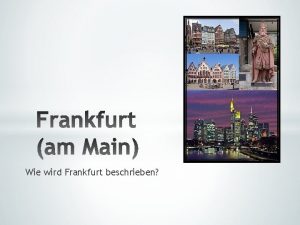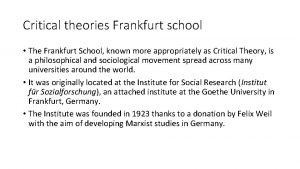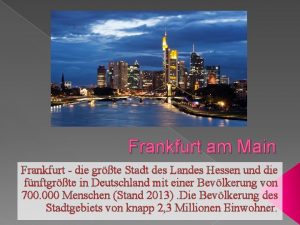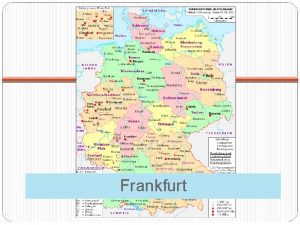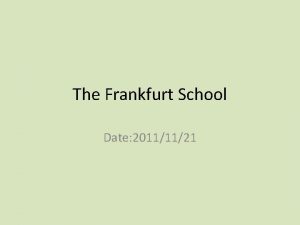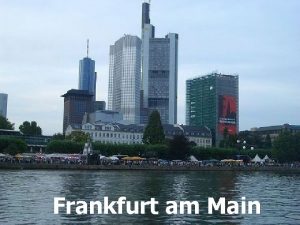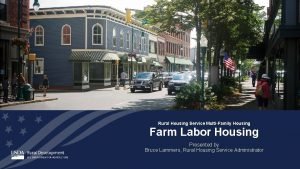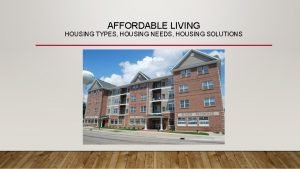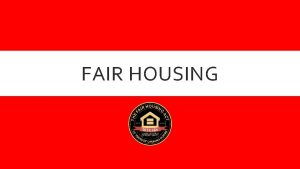ERNST MAY HOUSING POLICY OF FRANKFURT ON THE



























- Slides: 27

ERNST MAY HOUSING POLICY OF FRANKFURT ON THE MAIN (1929) Ahsen Senem Sırma

Hello my friends, today, I am going to talk about the ‘Housing Policy of Frankfurt on the Main. I’ll cover the topic in terms of architect of the project, effective person on him, Germany condition, planning of the Project, process of the Project, base of Project, approaching garden city concept and examples.

• Born in Frankfurt Lived United Kingdom 4 years and work with Raymond Unwin • • Garden City Movement Technical University of Munich • Worked with Theodor Fischer • Co-founder of Deutsche Weekbund (German Association of Craftsman) • In Breslau, experimented with methods of pre-fabrication • • Became a director of city planner for Munich in 1925 Spent many years in Africa • • Came back to Germany

Architect of the Project was Ernst May. He was born in Frankfurt. He Kingdom for 4 years. He study with Raymond Unwin. He absorbed principles of the garden city movement from him. He finished study University of Munich. He work with Theodor Fischer. had been United the lessons and at the Technical He was co-founder of the Deutsche Weekbund(German Association of Craftsman)that was established by many artists, architects, designer and industrials. It was an important element in the process of developing modern architecture and it was also foundation of Bauhaus. He won a competition for rural housing estate developments in Breslau. He experimented with methods of prefabrication in multi-family housing in 1918. he focus on producing rather than design process. He became a director of city architect and planner for Munich in 1925. He had many occasion in terms of power and Money because of Mayor of Munich. He left Munich when Nazis became big power in Germany and he spent time many years in Africa but he came back to Germany his last years.

Sir Raymond Unwin Theodor Fischer

Sir Raymond Unwin was a prominent and influential English engineer, architect and town planner, with an emphasis on improvements in working class housing. Theodor Fischer was a German architect. He planneed public housing projects for Munich. He was a member of the German Garden City movement. He was close to German tradition. He focused on working local context and the sociocultural character of the region with an eye toward the social effect of his plans. Both architects had been known with their remarkable garden city idea. In fact, many impressed their city ideas and Ernst rationalized their garden city concept in Frankfurt on the Main Project.

• Suffered First World War • Population had increased • • Economical problem A new law- Hauszinssture Act in 1924 • A fund to built a city

Germany was suffered because of First World War. Frankfurt population was tried to increase and it was successful. Town and housing sectors were not enough for citizens. People couldn’t find a house easily in terms of economy or needs. The German economy affected from war. Because of this, the government made a law to produce the housing. Hauszinsstuer Act in 1924 included taxes homeowners in local area. The taxes were created a fund to built a city and Ernst May became director of this city planning.

• • Minimal spaces maximum efficiency Concept of standardization and pre-fabrication • Wohn Kultur The plan and process created under May’s direction were to serve as stimulants in support of creating a new social milieu. He was consider that a city planning reflects the needs of citizen rather than their attitudes. New concept of living- Wohnkultur Local cooperative store, day care centers, common using areas, community areas, shopping areas, playground, guest houses, schools, theaters Needs of citizens

May approach the housing problem in Frankfurt with the efficiency of Frederich Winslow Taylor who was an American mechanical engineer. May designed several housing in Frankfurt under concept of standardization and prefabrication. He wanted to design minimal spaces with maximum efficiency. May also was consider that a city planning reflects the needs of citizen. The plan and process created under May’s direction were to serve as stimulants in support of creating a new social milieu. Planning which was the reflect the perceived needs of citizenry rather than their attitudes, was to introduce and lead them to an are in which the new society was to be formed. The attempt was to create a new concept of living «Wohn Kultur» . The new concept of living included local cooperative store, day care centers, common using areas, community areas, shopping areas, playground, guest houses, schools, theaters. May also favored low-rise townhouses with gardens and communal green areas and it was this model of housing that he proposed to CIAM.


For the beginning of the process, first thing is residential house needs. It was designed for small families there are some important points to give attention during process. Budget limitation- the location of settlements was the least expensive areas. Houses must be fit the need of people. Houses were designed with minimum existence. Location of existing housing in Frankfurt is unhealthy condition. New location should be healthy and sanitary. Settlements provided places for living, learning, working and recreation. While creating Wohn Kultur, housing and city planning would reflect the new society in respectfully community values and icons. All process developed in less than a year.

• • 26 settlements near the Nidda River Valley Flat roof, zigzag site layout, reflecting pool, sun loggia, wide bands of colors Practical and idealistic goals • • • Holistic approach The idea of modernization

In Frankfurt on the Main Project, practical and idealistic aims were happened successfully. 26 settlements were placed along the Nidda River Valley. They planned with unique land use, city planning, management concept, built-in element, revolutionary element The settlement included flat roof, zigzag site layout, reflecting pool, sun loggia, wide bands of colors. These aim and elements were very radical decisions in that period. All decisions could applied under the idea of modernization. Whole Project was designed in a holistic approach. May defined the area for agricultural use and it could serve as a green belt it separated the older city. Wohn Kultur concept applied as a local cooperative store, day care centers, common using areas, community areas, shopping centers, playground, guests house, schools and theaters.

Frankfurt Kitchen Both sides are useful • • Connect living room • Unusual for Europe

Small units, small rooms, small kitchen and also small furnitures were designed. Small kitchen called as Frankfurt Kitchen. Best example about the using space efficiently was the kitchen. It was designed by Frau Grete Lihotsky. Both sides are useful and there is sliding door which supports the entrance of living room. The kitchen has all normal applications and fixtures. It designed with a compact spatial arrangement. It was unusual for Europe but it became popular for modern kitchen design.

May edited a architectural magazine called «Das Neue Frankfurt» to give information to the public about project.

The construction concomitantly, May was in 1926 together with magazine ‘Das Neue Frankfurt’ out, which was to serve as a mouth piece and the wide and easily information to the public. In it , he advocated a shift away from absolute residential and design ideas. He was in charge of the municipally controlled limited dividend house construction cooperatives and edited the architectural magazine.

English Garden City Movement • Balance induvial and community needs • Include library, museum, school, factories, residential areas • Control overcrowded cities after Industrial Revolution • • Blend city and nature Traditional English style

English garden city concept is the first example about it. The aim was to create balance individual and community needs and creation of new suburban town of limited size. The other words, the aim was to control overcrowded town after Industrial Revolution. It included library, museum, school, commercial and residential areas. The plans were regularly geometrical circular and there was centralization. The houses reflect the English traditions.

Approach of Garden City Concept in German version Layout for gardening • • • Garden colonies • Grown food Walkways, bicycle paths, sports area, forest area • Economical reasons

May rationalized their garden city concept. Designers developed layouts for gardening. Landscape architects designed garden colonies and integrated in to the Project. Structures were fix in a natural environment. Garden colonies were designed in terms of shortages and wohn kultur. These are connected people with the natural environment in cultural sense. It allowed to the people to grow own food. Walkways, bicycle paths, sports areas, forest area designed to to support common area and ideas.

«The word ‘Garden City’ has become a great collective term, in which one fairly indiscriminately variety settlement structure raises in - regardless of social foundation and objective. » Bernhard Kampffmeyer who was a socialist, sympathetic to anarchism journalist and activist. He supported the project- German version Garden City Movement.

Many politicians, journalists and social instructions support the idea of Garden City in Germany. Here is an example.

Römerstadt

Praunheim

THANK YOU FOR READING!
 Housing first frankfurt
Housing first frankfurt Major ernst killander
Major ernst killander Flexibility
Flexibility Composizione ovale con alberi mondrian
Composizione ovale con alberi mondrian Max ernst fruit d'une longue expérience
Max ernst fruit d'une longue expérience Whats a climax community
Whats a climax community Ernst krieck pädagogik
Ernst krieck pädagogik Jens ernst
Jens ernst Max ernst ervaringen
Max ernst ervaringen Markierung einer wende ernst jandl
Markierung einer wende ernst jandl Max ernst le rossignol chinois
Max ernst le rossignol chinois Ernst and young tax services
Ernst and young tax services Pseudowetenschap beoefend door karl ernst krafft
Pseudowetenschap beoefend door karl ernst krafft Ernst and young moldova
Ernst and young moldova Dekalkomanie max ernst
Dekalkomanie max ernst Massenentlassung schweiz definition
Massenentlassung schweiz definition Ernst v. conditt
Ernst v. conditt Cartoon analysis
Cartoon analysis Fuchskirche thal
Fuchskirche thal Ernst schweizer
Ernst schweizer Max ernst frotáž
Max ernst frotáž Yaron ernst
Yaron ernst Ernst schmidheiny stiftung
Ernst schmidheiny stiftung Ernst george ravenstein
Ernst george ravenstein Ernst lofvers
Ernst lofvers Ernst ravenstein ap human geography
Ernst ravenstein ap human geography Ernst & young advisory
Ernst & young advisory Biotic community is another name for____
Biotic community is another name for____
